'Ain Ghazal Statues
The Ain Ghazal Statues are a number of monumental lime plaster and reed statues dated to the Pre-Pottery Neolithic C period have been discovered in Jordan, at the site of Ayn Ghazal. A total of 15 statues and 15 busts were discovered in 1983 and 1985 in two underground caches, created about 200 years apart.[3]
| Ayn Ghazal statues | |
|---|---|
Closeup of one of the bicephalous statues. | |
| Material | plaster and reed |
| Size | 32 items |
| Created | 7200 BC[1] - c. 6500 BC[2] |
| Discovered | 1983 Ayn Ghazal, Amman, Jordan 31.988°N 35.976°E |
| Present location | The Jordan Museum |
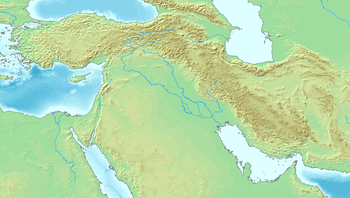 'Ain Ghazal  'Ain Ghazal | |
Dating to between the mid-7th millennium BC and the mid-8th millennium BC,[2] the statues are among the earliest large-scale representations of the human form, and are regarded to be one of the most remarkable specimens of prehistoric art from the Pre-Pottery Neolithic B or C period.[4] Some earlier human statues are known from Upper Mesopotamia, such as the Urfa Man.[5][6][7]
Although it is held that they represented the ancestors of those in the village, their purpose remains uncertain.[8]
They are all part of the collection of the Jordan Museum in Amman, but some have been loaned elsewhere, or sent for conservation. One statue is in the Louvre Museum in Paris. One of the figures with two heads in on show in the Louvre Abu Dhabi.[9] Two statues were being conserved in the British Museum in London in 2013.
Description
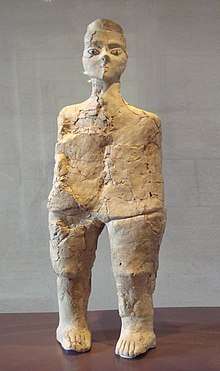
The figures are of two types, full statues and busts. Some of the busts are two-headed. Great effort was put into modelling the heads, with wide-open eyes and bitumen-outlined irises. The statues represent men, women and children; women are recognizable by features resembling breasts and slightly enlarged bellies, but neither male nor female sexual characteristics are emphasized, and none of the statues have genitals, the only part of the statue fashioned with any amount of detail being the faces.[10]
The statues were formed by modelling moist plaster from limestone on a reed core using plants that grew along the banks of the Zarqa River. The reed decayed over the millennia, leaving plaster shells with a hollow interior. Lime plaster is formed by heating limestone to temperatures between 600 and 900 degrees celsius; the product, hydrated lime is then combined with water to make a dough, which was then modelled. Plaster becomes a water-resistant material when it dries and hardens. Heads, torsos and legs were formed from separate bundles of reeds which were then assembled and covered in plaster. The irises were outlined with bitumen and the heads were covered with some sort of wig.[11]
They are comparatively tall, but not human-sized, the tallest statues having a height of close to 1 m. They are disproportionately flat, about 10 cm in thickness. They were nevertheless designed to stand up, probably anchored to the floor in enclosed areas and intended to be seen only from the front.[12][13] The way the statues were made would not have permitted them to last long. And since they were buried in pristine condition it is possible that they were never on display for any extended period of time, but rather produced for the purpose of intentional burial.[10]
Discovery and conservation
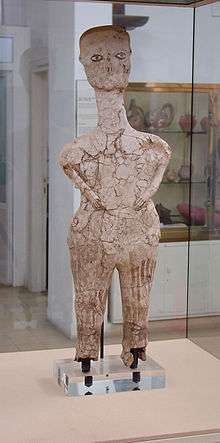
The site of Ayn Ghazal was discovered in 1974 by developers who were building a highway connecting Amman to the city of Zarqa. Excavation began in 1982. The site was inhabited during ca. 7250–5000 BC.[14] In its prime era, during the first half of the 7th millennium BC, the settlement extended over 10–15 hectares (25–37 ac) and was inhabited by ca. 3000 people.[14]
The statues were discovered in 1983. While examining a cross section of earth in a path carved out by a bulldozer, archaeologists came across the edge of a large pit 2.5 meters (8 ft) under the surface containing plaster statues. Excavation led by Gary O. Rollefson took place in 1984/5, with a second set of excavation under the direction of Rollefson and Zeidan Kafafi during 1993–1996.[15]
A total of 15 statues and 15 busts were found in two caches, which were separated by nearly 200 years. Because they were carefully deposited in pits dug into the floors of abandoned houses, they are remarkably well-preserved.[16] Remains of similar statues found at Jericho and Nahal Hemar have survived only in fragmentary state.[12]
The pit where the statues were found was carefully dug around, and the contents were placed in a wooden box filled with polyurethane foam for protection during shipping.[11] The statues are made of plaster, which is fragile especially after being buried for so long. The first set of statues discovered at the site was sent to the Royal Archaeological Institute in Great Britain, while the second set, found a few years later, were sent to the Smithsonian Institution in New York for restoration work. The statues were returned to Jordan after their conservation and can be seen in the Jordan Museum.[17]
Part of the find was on loan in the British Museum in 2013. One specimen was still being restored in Britain as of 2012.[18]
Gallery
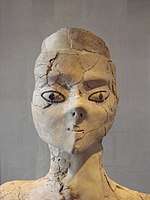 Louvre Ain Ghazal statue, frontal
Louvre Ain Ghazal statue, frontal Louvre Ain Ghazal statue left profile
Louvre Ain Ghazal statue left profile Louvre Ain Ghazal statue right profile
Louvre Ain Ghazal statue right profile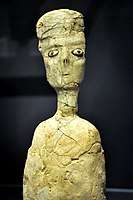 Micah, Ain Ghazal Statue, the British Museum
Micah, Ain Ghazal Statue, the British Museum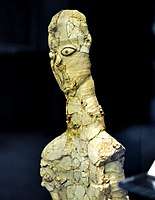 Noah, Ain Ghazal Statue, the British Museum
Noah, Ain Ghazal Statue, the British Museum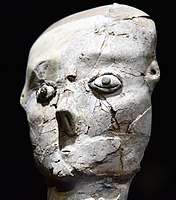 Head, human statue from Aig Ghazal, Amman, the Jordan Museum
Head, human statue from Aig Ghazal, Amman, the Jordan Museum Double-headed statue from Ain Ghazal, Amman, Jordan Archaeological Museum
Double-headed statue from Ain Ghazal, Amman, Jordan Archaeological Museum Statue, human, from Ain Ghazal city, Amman, Jordan Archaeological Museum
Statue, human, from Ain Ghazal city, Amman, Jordan Archaeological Museum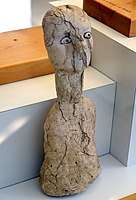 Statue, human, from Ain Ghazal, Amman, Jordan Archaeological Museum
Statue, human, from Ain Ghazal, Amman, Jordan Archaeological Museum Two-headed statue from Ain Ghazal, Jordan Museum, Amman
Two-headed statue from Ain Ghazal, Jordan Museum, Amman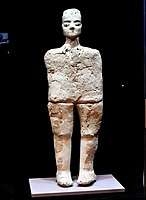 Human statue from Ain Ghazal, Amman city, Jordan Museum
Human statue from Ain Ghazal, Amman city, Jordan Museum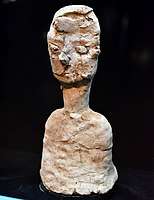 Human statue from Ain Ghazal, Jordan Museum, Amman
Human statue from Ain Ghazal, Jordan Museum, Amman
See also
| Wikimedia Commons has media related to Sculptures of Ain Ghazal. |
- Amman Citadel
- Ancestor Statue, Jericho, c. 9000 BC
- Urfa Man, c. 9000 BC
References
- Besim Ben-Nissan (17 April 2014). "Advances in Calcium Phosphate Biomaterials". Springer Science & Business. p. 436. Retrieved 5 July 2016.
- Kleiner, Fred S.; Mamiya, Christin J. (2006). Gardner's Art Through the Ages: The Western Perspective: Volume 1 (Twelfth ed.). Belmont, California: Wadsworth Publishing. p. 25. ISBN 0-495-00479-0. "ca. 6250 6250 BCE".
- McCarter, Susan (12 November 2012). Neolithic. Routledge. pp. 161–163. ISBN 9781134220397. Retrieved 20 June 2016. G. O. Rollefson in: Ian Kuijt (ed.), Life in Neolithic Farming Communities: Social Organization, Identity, and Differentiation, Springer (2006), p. 153.
- "Lime Plaster statues". British Museum. Trustees of the British Museum. Archived from the original on 18 October 2015. Retrieved 21 September 2015. The tallest of the Ayn Ghazal statues reach about 1 m in height, and they are assumed to have been free-standing, anchored in the ground (although they could not stand up unsupported). Upper Paleolithic figurines tend to be smaller than 20 cm in height. Taller representations of the human form from the Paleolithic era, such as the Venus of Laussel, are in bas-relief or painted.
- Chacon, Richard J.; Mendoza, Rubén G. (2017). Feast, Famine or Fighting?: Multiple Pathways to Social Complexity. Springer. p. 120. ISBN 9783319484020.
- Schmidt, Klaus (2015). Premier temple. Göbekli tepe (Le): Göbelki Tepe (in French). CNRS Editions. p. 291. ISBN 9782271081872.
- Collins, Andrew (2014). Gobekli Tepe: Genesis of the Gods: The Temple of the Watchers and the Discovery of Eden. Simon and Schuster. p. 66. ISBN 9781591438359.
- Feldman, Keffie. "Ain-Ghazal (Jordan) Pre-pottery Neolithic B Period pit of lime plaster human figures". Joukowsky Institute, Brown University. Retrieved 16 June 2018.
They are largely held to represent the ancestors of those in the community, or variations on this theme. One can make the argument for this based on the similar treatment of the heads of these statues and the disarticulated and buried plastered skulls. The burial of the statues is also similar to the manner in which the people of Ain Ghazal buried their dead. However, what if these statues are not representations at all, but instead are enlivened objects themselves? What if they were buried in a similar manner to humans because they were thought to have died, or have lost their animate powers? These statues bring up equally many questions as answers, and for this reason will provide a rich site for future study.
- Stanley Carvalho (2017-11-07). "East meets West as Louvre Abu Dhabi opens in the Gulf". Reuters. Retrieved 2019-11-15.
- Susan McCarter, Neolithic, Routledge, 2012, p. 163.
- "Neolithic Statues from Jordan". Archived from the original on 20 February 2001. Retrieved 20 June 2016.
- Susan McCarter, Neolithic, Routledge, 2012, p. 161. Cache 1: Sq 2083 Loc. 20: 13 full figures, 12 one-headed busts Cache 2: Sq 3282 Loc 049: 2 figures, 3 two-headed busts and 2 unidentified pieces.
- McGovern, Patrick E (30 October 2010). Uncorking the Past: The Quest for Wine, Beer, and Other Alcoholic Beverages. University of California Press. p. 91. ISBN 9780520944688. Retrieved 20 June 2016.
- Graeme Barker; Candice Goucher (16 April 2015). The Cambridge World History: Volume 2, A World with Agriculture, 12,000 BCE–500 CE. Cambridge University Press. pp. 426–. ISBN 978-1-316-29778-0.
- preliminary excavation reports: Rollefson, G., and Kafafi, Z. Annual of the Department of Antiquities of Jordan 38 (1994), 11–32; 40 (1996), 11–28; 41 (1997), 27–48.
- Kathryn W. Tubb, The statues of 'Ain Ghazal: discovery, recovery and reconstruction, Archaeology International
- Kafafi, Zeidan. "Ayn Ghazal. A 10,000 year-old Jordanian village". Atlas of Jordan.
- "تماثيل عين غزال تنتظر عودة "شقيق مهاجر" من لندن منذ ثلاثة عقود". Ad Dustour (in Arabic). 11 January 2012. Archived from the original on 2016-08-07. Retrieved 5 July 2016.
- Akkermans, Peter M.M.G. and Glenn M. Schwartz (2003), The archaeology of Syria: from complex hunter-gatherers to early urban societies (ca. 16,000–300 BC), Cambridge World Archaeology, Cambridge University Press, pp. 83ff.
- Grissom, C.A. (2000), "Neolithic statues from 'Ain Ghazal: construction and form", American Journal of Archaeology 104, 25–45.
- Rollefson, G.O. (1983), "Ritual and ceremony at Neolithic 'Ain Ghazal (Jordan)". Paleorient 9, 29–38.
- Rollefson, G.O. (1984), "Early Neolithic statuary from 'Ain Ghazal (Jordan)", Mitteilungen der Deutschen Orient-Gesellschaft 116, 185–192.
- Rollefson, G.O. (1986), "Neolithic 'Ain Ghazal (Jordan)- Ritual and ceremony II", Paleorient 12, 45–51.